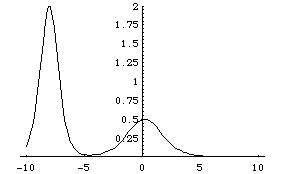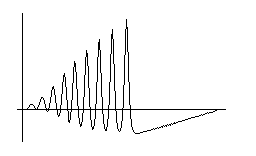 Permanent Exhibition
Permanent Exhibition
Switch to Japanese
Many Faces of Solitons
Kanehisa Takasaki (Kyoto University)
Entrance --
KdV equation --
Modified KdV equation --
Sine-Gordon equation
 Next Room
Next Room
KdV equation ut + uxxx + 6uux= 0
The Korteweg-de Vries (KdV) equation is the champion of
model equations of nonlinear waves. It was studied by
Korteweg and de Vries late in the 19th century as a water
wave equation, and after a long period of sleep, revived
as one of the most fundamental equation of soliton phenomena.
In fact, it is from numerical experiments of this equation
that Zabusky and Kruskal introduced the term "soliton".
- 2-soliton solution
[gif]
Here is an animation of the 2-soliton solution
(solution with two solitons). Solitons emerge
as peeks of the solution. A tall (fast) soliton
is approaching a little (slow) soliton from the left.
They will soon merge, and separate again.
Be sure that the ratio of height and width is
quite large; the real profile is more like a
flatter water wave just like the soliton
observed by Scott Russel.

[profile of 2-soliton solution before collision]
solution: u = 2*(Log f)_{xx},
f = 1 + Exp[eta1] + Exp[eta2] + c12*Exp[eta1+eta2],
eta1 = k1*(x - x1) - k1^3*t, eta2 = k2*(x - x2) - k2^3*t,
c12 = (k1-k2)^2 / (k1+k2)^2.
parameters: k1 = 2, k2 = 1, x1 = -8, x2 = -2.
- Emergence of solitons from sinusoidal wave
[gif]
Zabusky and Kruskal discovered solitons in numerical
solutions of the KdV equation. Here is an animation
of such a numerical solution. The setting is almost
the same as the computation of Zabusky and Kruskal:
1) The equation is solved by the same difference scheme
(the Cranck - Nicolson or "leap-frog" method). 2) The
equation is solved under a periodic boundary condition.
3) The initial value is a sinusoidal wave with one
period over the whole space.
The numerical solution shows that the sinusoidal wave
soon developes into a train of solitons. The tail of
the soliton train grows backward, and eventually overlap
with the head solitons. You can observe collision of
solitons in this overlapping region.

[soliton train developed from sinusoidal initial value]
 Permanent Exhibition
Permanent Exhibition Permanent Exhibition
Permanent Exhibition
